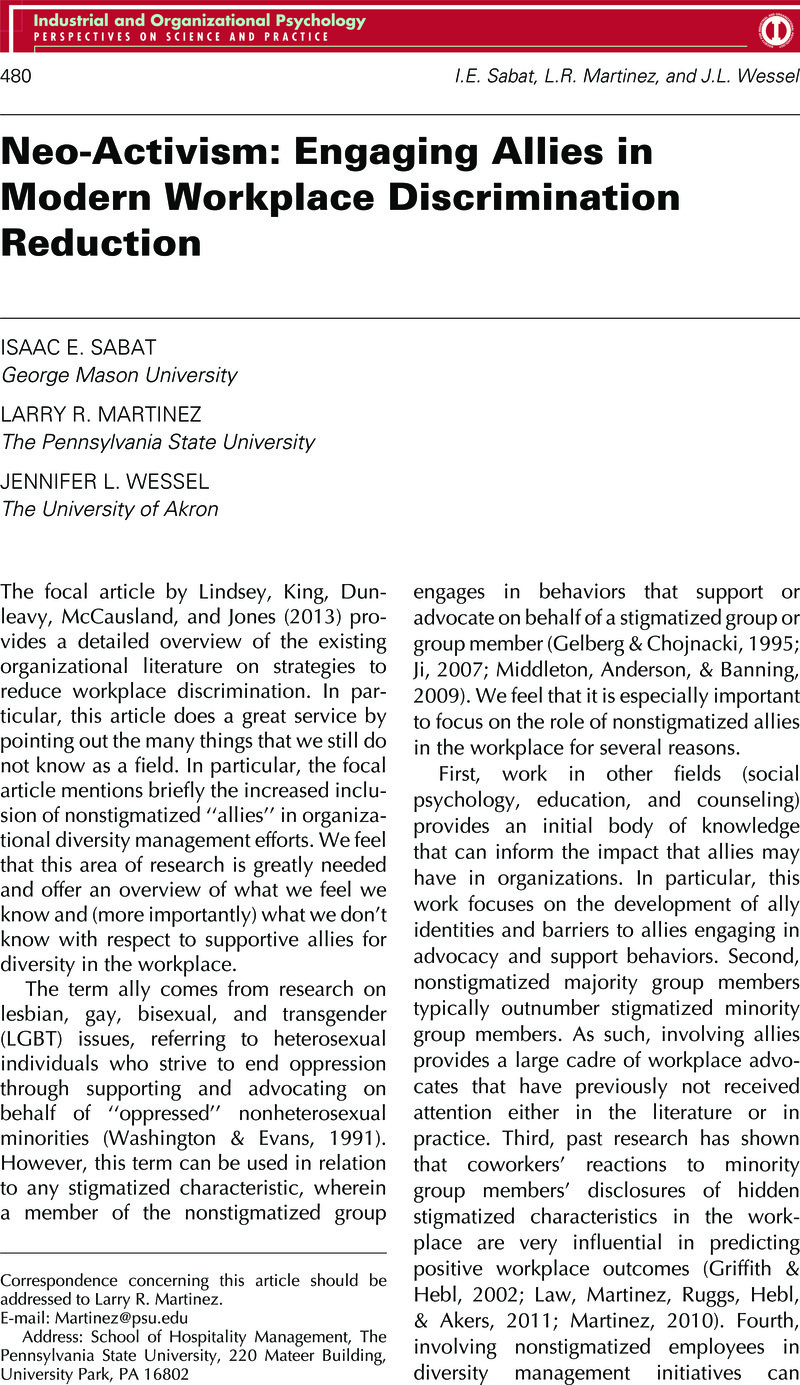Crossref Citations
This article has been cited by the following publications. This list is generated based on data provided by Crossref.
Sabat, Isaac
Lindsey, Alex
and
King, Eden
2014.
The Role of Demographics in Occupational Stress and Well Being.
Vol. 12,
Issue. ,
p.
173.
Sabat, Isaac E.
Lindsey, Alex P.
Membere, Ashley
Anderson, Amanda
Ahmad, Afra
King, Eden
and
Bolunmez, Balca
2014.
Invisible Disabilities: Unique Strategies for Workplace Allies.
Industrial and Organizational Psychology,
Vol. 7,
Issue. 2,
p.
259.
Sabat, Isaac
Lindsey, Alex
and
King, Eden
2014.
The Role of Demographics in Occupational Stress and Well Being.
Vol. 12,
Issue. ,
p.
173.
Sabat, Isaac E.
Lindsey, Alex P.
King, Eden B.
and
Jones, Kristen P.
2016.
Research Perspectives on Work and the Transition to Motherhood.
p.
9.
Jones, Kristen P.
Arena, Dave F.
Nittrouer, Christine L.
Alonso, Natalya M.
and
Lindsey, Alex P.
2017.
Subtle Discrimination in the Workplace: A Vicious Cycle.
Industrial and Organizational Psychology,
Vol. 10,
Issue. 1,
p.
51.
Martinez, Larry R.
Hebl, Michelle R.
Smith, Nicholas A.
and
Sabat, Isaac E.
2017.
Standing up and speaking out against prejudice toward gay men in the workplace.
Journal of Vocational Behavior,
Vol. 103,
Issue. ,
p.
71.
Ng, Eddy S.
and
Rumens, Nick
2017.
Diversity and inclusion for LGBT workers: Current issues and new horizons for research.
Canadian Journal of Administrative Sciences / Revue Canadienne des Sciences de l'Administration,
Vol. 34,
Issue. 2,
p.
109.
Hernandez, Theresa R.
Bernard, Liana
and
Martinez, Larry R.
2018.
Let the Pigs Fly: What We Say and How We Say It When We Talk About Gender.
Industrial and Organizational Psychology,
Vol. 11,
Issue. 3,
p.
419.
Jaurique, Alexandria
Ryan, Desiree A.
Smith, Heather J.
and
Paolucci‐Callahan, Matthew
2019.
Observing Discrimination: Implications for Group‐Based Respect and Organizational Morality.
Social Issues and Policy Review,
Vol. 13,
Issue. 1,
p.
125.
Salter, Nicholas P.
and
Migliaccio, Leslie
2019.
Diversity within Diversity Management.
Vol. 22,
Issue. ,
p.
131.
Ahmad, Afra Saeed
Sabat, Isaac
Trump-Steele, Rachel
and
King, Eden
2019.
Evidence-Based Strategies for Improving Diversity and Inclusion in Undergraduate Research Labs.
Frontiers in Psychology,
Vol. 10,
Issue. ,
Lyons, Brent J.
Lynch, John W.
and
Johnson, Tiffany D.
2020.
Gay and lesbian disclosure and heterosexual identity threat: The role of heterosexual identity commitment in shaping de-stigmatization.
Organizational Behavior and Human Decision Processes,
Vol. 160,
Issue. ,
p.
1.
Sawyer, Katina
Young, Stephen F.
Thoroughgood, Christian
and
Dominguez, Kizzy M.
2020.
Does Reducing Male Domination in Teams Attenuate or Intensify the Harmful Effects of Perceived Discrimination on Women's Job Satisfaction? A Test of Competing Hypotheses.
Applied Psychology,
Vol. 69,
Issue. 2,
p.
557.
Grandey, Alicia A.
Gabriel, Allison S.
and
King, Eden B.
2020.
Tackling Taboo Topics: A Review of the Three Ms in Working Women’s Lives.
Journal of Management,
Vol. 46,
Issue. 1,
p.
7.
Hernandez, Joel
Mahabir, Bhindai
and
Cheung, Ho Kwan
2020.
Applying I-O theories in classrooms: An examination from the power perspective.
Industrial and Organizational Psychology,
Vol. 13,
Issue. 4,
p.
548.
Gardner, Danielle M.
and
Alanis, Jo M.
2020.
Together we stand: Ally training for discrimination and harassment reduction.
Industrial and Organizational Psychology,
Vol. 13,
Issue. 2,
p.
196.
Pasha-Zaidi, Nausheen
Warren, Meg A.
El Ashmawi, Yvonne
and
Kowai-Bell, Neneh
2021.
Toward a Positive Psychology of Islam and Muslims.
Vol. 15,
Issue. ,
p.
307.
Pufahl, J.
Rawat, S.
Chaudary, J.
and
Shiff, N.J.
2021.
Even Mists Have Silver Linings: Promoting LGBTQ+ Acceptance and Solidarity through Community-Based Theatre in India.
Public Health,
Vol. 194,
Issue. ,
p.
252.
Collins, Joshua C.
Zhang, Panpan
and
Sisco, Stephanie
2021.
Everyone is Invited: Leveraging Bystander Intervention and Ally Development to Cultivate Social Justice in the Workplace.
Human Resource Development Review,
Vol. 20,
Issue. 4,
p.
486.
Griffith, Jennifer
Malone, Mary Fran T.
and
Shea, Christine M.
2022.
From bystander to ally among faculty colleagues: construction and validation of the bystander intervention behavior scale.
Equality, Diversity and Inclusion: An International Journal,
Vol. 41,
Issue. 2,
p.
273.



